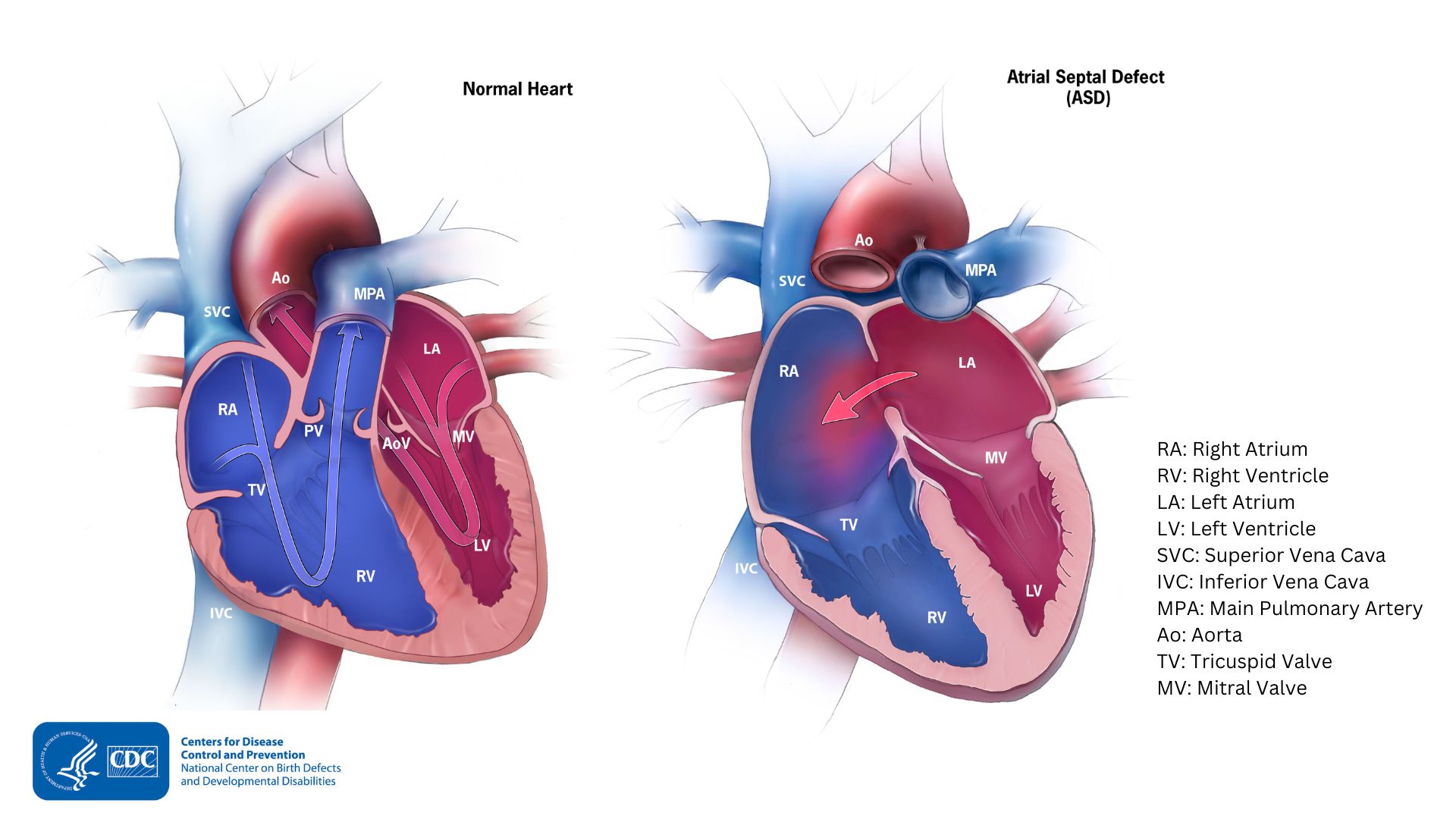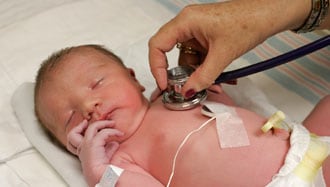Key points
- An atrial septal defect (pronounced EY-tree-uhl SEP-tuhl DEE-fekt) or ASD is a congenital heart defect. Congenital means present at birth.
- An atrial septal defect is a hole in the wall (septum) that divides the upper chambers (atria) of the heart.
- People with this condition should schedule routine checkups with a heart doctor to stay as healthy as possible.

What it is
An atrial septal defect is a hole in the wall (septum) that divides the upper chambers (atria) of the heart. The hole can vary in size and may close on its own or require surgery.
As a baby's heart develops during pregnancy, several openings in the wall divide the upper chambers of the heart (atria). These openings normally close during pregnancy or shortly after birth. If one of these openings does not close, a hole remains, and it is called an atrial septal defect (ASD).

Occurrence
About 13 of every 10,000 babies in the United States are born with an atrial septal defect.1 This means that about 5,240 babies are born with an atrial septal defect each year.
Signs and symptoms
An atrial septal defect is present at birth, but many babies do not have any signs or symptoms. Signs and symptoms of a large or untreated atrial septal defect may include:
- Frequent respiratory or lung infections
- Difficulty breathing or shortness of breath when physically active
- Tiring when feeding (infants)
- Skipped heartbeats or a sense of feeling the heartbeat
- A whooshing sound that can be heard with a stethoscope (heart murmur)
- Swelling of legs, feet, or stomach area
- Stroke
Risk factors
The causes of atrial septal defects among most babies are unknown. Some babies have heart defects because of changes in their genes or chromosomes. A combination of genes and other risk factors may increase the risk for atrial septal defects. These factors can include things in a mother's environment, what she eats or drinks, or the medicines she uses.
Diagnosis
An atrial septal defect may be diagnosed during pregnancy or after the baby is born.
During pregnancy
During pregnancy, screening tests (prenatal tests) check for birth defects and other conditions. An ultrasound, a tool that creates pictures of the baby, may detect an atrial septal defect. However, it usually depends on the size of the hole and its location. If an atrial septal defect is suspected, a healthcare provider will need to confirm the diagnosis.
After a baby is born
In many cases, an atrial septal defect may not be diagnosed until adulthood. An atrial septal defect is often found by detecting a murmur when listening to a person's heart with a stethoscope. If a murmur is heard or other symptoms are present, the healthcare provider might request more tests to confirm the diagnosis. The most common test is an echocardiogram, which is an ultrasound of the heart.

Treatments
Treatment for an atrial septal defect depends on many factors:
- The age of diagnosis
- The number of or seriousness of symptoms
- The size of the hole
- The presence of other conditions
Sometimes surgery is needed to repair the hole. Medications can be prescribed to help treat symptoms. There are no known medications that can repair the hole.
With an atrial septal defect diagnosis, the healthcare provider may monitor it to see if the hole closes on its own. During this period of time, the healthcare provider might treat symptoms with medicine. If a child has a large atrial septal defect, the healthcare provider may recommend that it be closed. This will prevent problems later in life.
Closure may also be recommended for an adult who has many or severe symptoms. Closure of the hole may be done during cardiac catheterization or open-heart surgery. After these procedures, follow-up care will depend on a few factors:
- The size of the defect
- The person's age
- Whether the person has other birth defects
Sometimes the atrial septal defect can't be fully repaired. However, procedures to close the hole can improve blood flow and the way the heart works. For some people, even if their heart defect has been repaired, they are not cured and will require follow-up care.
What to expect long-term
An untreated atrial septal defect increases the amount of blood that flows through the lungs. Overtime, an unrepaired atrial septal defect may cause damage to the blood vessels in the lungs.
Damage to the blood vessels in the lungs may cause problems in adulthood, such as:
- High blood pressure in the lungs
- Heart failure
- Abnormal heartbeat
- Increased risk of stroke
Even if their heart defect has been surgically repaired, many people with an atrial septal defect are not cured. People with atrial septal defects may develop other health problems over time. People with atrial septal defects should schedule routine checkups with a cardiologist (heart doctor) to stay as healthy as possible.
- Reller MD, Strickland MJ, Riehle-Colarusso T, Mahle WT, Correa A. Prevalence of Congenital Heart Defects in Metropolitan Atlanta, 1998-2005. J Pediatr. 2008;153:807-13
